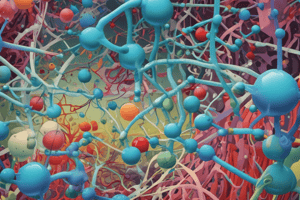Podcast
Questions and Answers
What does reversible covalent modification refer to?
What does reversible covalent modification refer to?
- The permanent alteration of a protein's structure.
- The thermodynamic reversibility of a single enzymatic reaction.
- The ability to undo a covalent modification through a separate enzymatic reaction. (correct)
- The modification of a protein that cannot be reversed.
Which of the following amino acids can be phosphorylated?
Which of the following amino acids can be phosphorylated?
- Methionine
- Proline
- Cysteine
- Serine (correct)
What role does a kinase play in phosphorylation?
What role does a kinase play in phosphorylation?
- It hydrolyzes ATP to generate energy.
- It adds phosphate groups to proteins. (correct)
- It stabilizes protein structures.
- It removes phosphate groups from proteins.
How is the phosphate group typically removed from a phosphorylated protein?
How is the phosphate group typically removed from a phosphorylated protein?
What is the primary thermodynamic characteristic of the kinase and phosphatase reactions?
What is the primary thermodynamic characteristic of the kinase and phosphatase reactions?
What is the effect of phosphorylation on enzymes?
What is the effect of phosphorylation on enzymes?
Which of the following is NOT a type of post-translational modification?
Which of the following is NOT a type of post-translational modification?
What byproduct is generated during the removal of a phosphate group by phosphatase?
What byproduct is generated during the removal of a phosphate group by phosphatase?
What are zymogens specifically known for?
What are zymogens specifically known for?
Which of the following statements about pepsinogen is true?
Which of the following statements about pepsinogen is true?
Which of the following is an example of a covalent modification that can regulate enzyme activity?
Which of the following is an example of a covalent modification that can regulate enzyme activity?
What characterizes dynamic covalent modifications of enzymes?
What characterizes dynamic covalent modifications of enzymes?
How do irreversible inhibitors affect enzymes?
How do irreversible inhibitors affect enzymes?
Which of the following roles do zymogens play in biological systems?
Which of the following roles do zymogens play in biological systems?
What results from the proteolytic cleavage of proinsulin?
What results from the proteolytic cleavage of proinsulin?
What is a key feature of most post-translational modifications?
What is a key feature of most post-translational modifications?
What is the primary result of a single activated Kinase A in the signal cascade?
What is the primary result of a single activated Kinase A in the signal cascade?
How do feedback or allosteric modulators differ from covalent modifications?
How do feedback or allosteric modulators differ from covalent modifications?
What role do phosphatases play in overriding feedback inhibition during glycolysis?
What role do phosphatases play in overriding feedback inhibition during glycolysis?
Which of the following statements is true regarding dynamic covalent modifications of enzymes?
Which of the following statements is true regarding dynamic covalent modifications of enzymes?
What is the mechanism by which modulation is achieved in feedback regulation?
What is the mechanism by which modulation is achieved in feedback regulation?
In the context of enzyme activity, how does the signal amplification affect cellular response?
In the context of enzyme activity, how does the signal amplification affect cellular response?
Which statement accurately reflects the comparison between feedback modulation and covalent modification?
Which statement accurately reflects the comparison between feedback modulation and covalent modification?
What effect does high ATP concentration typically have on glycolysis?
What effect does high ATP concentration typically have on glycolysis?
What is the effect of phosphorylation on glycogen synthase?
What is the effect of phosphorylation on glycogen synthase?
How does phosphorylation affect enzyme activity mechanistically?
How does phosphorylation affect enzyme activity mechanistically?
What defines an enzyme being 'turned on'?
What defines an enzyme being 'turned on'?
Which statement about phosphorylation sites on enzymes is true?
Which statement about phosphorylation sites on enzymes is true?
What advantage does covalent modification of enzymes provide?
What advantage does covalent modification of enzymes provide?
What occurs when glycogen phosphorylase is phosphorylated?
What occurs when glycogen phosphorylase is phosphorylated?
Which of the following enzymes would be classified as a kinase?
Which of the following enzymes would be classified as a kinase?
How can covalent modification amplify a cellular signal?
How can covalent modification amplify a cellular signal?
Flashcards
Proproteins
Proproteins
Proteins that are synthesized in an inactive form and then converted to an active form by proteolytic cleavage.
Zymogens
Zymogens
Proproteins that generate an enzyme upon cleavage.
Pepsinogen
Pepsinogen
An example of a zymogen that can proteolytically cleave itself under certain conditions, irreversibly converting it into its active form, pepsin.
Dynamic Covalent Modifications
Dynamic Covalent Modifications
Signup and view all the flashcards
Post-Translational Modifications (PTMs)
Post-Translational Modifications (PTMs)
Signup and view all the flashcards
Irreversible inhibitors
Irreversible inhibitors
Signup and view all the flashcards
Zymogen Activation
Zymogen Activation
Signup and view all the flashcards
Dynamic PTMs
Dynamic PTMs
Signup and view all the flashcards
Phosphorylation
Phosphorylation
Signup and view all the flashcards
Kinases
Kinases
Signup and view all the flashcards
Phosphatases
Phosphatases
Signup and view all the flashcards
Phosphorylation Status
Phosphorylation Status
Signup and view all the flashcards
Phosphorylation and Enzyme Activity
Phosphorylation and Enzyme Activity
Signup and view all the flashcards
Dynamic Regulation
Dynamic Regulation
Signup and view all the flashcards
Importance of Dynamic Modifications
Importance of Dynamic Modifications
Signup and view all the flashcards
Enzyme regulation by phosphorylation
Enzyme regulation by phosphorylation
Signup and view all the flashcards
How phosphorylation affects enzyme activity
How phosphorylation affects enzyme activity
Signup and view all the flashcards
Multiple phosphorylation sites
Multiple phosphorylation sites
Signup and view all the flashcards
Covalent modification as an enzyme regulation method
Covalent modification as an enzyme regulation method
Signup and view all the flashcards
Covalent modification's impact on allosteric signaling
Covalent modification's impact on allosteric signaling
Signup and view all the flashcards
Amplification in signal cascades
Amplification in signal cascades
Signup and view all the flashcards
Kinases and phosphatases in phosphorylation
Kinases and phosphatases in phosphorylation
Signup and view all the flashcards
Phosphorylation's role in signal cascades
Phosphorylation's role in signal cascades
Signup and view all the flashcards
Signal Amplification in Covalent Modification
Signal Amplification in Covalent Modification
Signup and view all the flashcards
Overriding Feedback Inhibition
Overriding Feedback Inhibition
Signup and view all the flashcards
Study Notes
Enzyme Regulation by Covalent Modifications
- Enzymes are commonly regulated by covalent modifications, in addition to allosteric regulation
- Covalent modifications are post-translational modifications that affect enzyme activity
- Proproteins are synthesized in an inactive form and converted to an active form by proteolytic cleavage
- Zymogens are proproteins that become enzymes after cleavage
- Pepsinogen is an example of a zymogen that is cleaved to form the active enzyme pepsin
- Pepsin can cleave more pepsinogen, an example of an enzyme that activates its own zymogen precursor
- Many zymogens are activated by separate enzymes, like trypsinogen cleaved by enteropeptidase
- The synthesis of enzymes as zymogens helps ensure they remain inactive until needed
- Zymogens are commonly found in digestion, clotting, and apoptotic pathways
- Aberrant early activation of zymogens can cause pathological consequences
Dynamic Covalent Modifications
- Some covalent modifications are irreversible, stopping enzyme activity
- Inhibitors are exogenous to the organism (e.g., drugs, toxins)
- Zymogen activation, part of a post-translational modification, is irreversible
- Both irreversible inhibition and zymogen activation are examples of post-translational modifications
- Dynamic covalent modifications are reversible, meaning they can be added and removed to regulate enzyme activity
- These modifications can be dynamic, adding or removing, which allows for regulation of enzyme activity
- Dynamic modification isn't the reversibility of a single enzymatic reaction, but the ability to alter it by another enzyme reaction
Phosphorylation
- Phosphorylation is a common dynamic covalent modification
- Addition of phosphate group to the hydroxyl of serine, threonine, or sometimes tyrosine
- Kinase enzymes catalyze the addition of phosphate using ATP
- Phosphate groups are removed by phosphatase enzymes
- Phosphate group addition causes a conformational change and affects enzyme activity (kcat/KM values)
- Kinase and phosphatase reactions, though individually considered irreversible, can reversibly regulate phosphorylation status
- Phosphorylation status of an enzyme can control activity; some are 'on' when phosphorylated, others 'off'
- Enzymes may have multiple phosphorylation sites, with effects varying by site
Signal Cascades and Multi-Target Effects
- Signal cascades, involving phosphorylation, can amplify cellular responses
- Kinases and phosphatases can affect multiple different enzymes and pathways
- Covalent regulation can override feedback mechanisms
- Phosphorylation plays a central role in hormonal regulation of metabolic processes
Studying That Suits You
Use AI to generate personalized quizzes and flashcards to suit your learning preferences.
Related Documents
Description
This quiz focuses on the regulation of enzymes through covalent modifications and the role of zymogens in enzymatic activity. It covers key concepts such as proproteins, pepsinogen, and the implications of early zymogen activation. Test your understanding of these vital biochemical processes!




